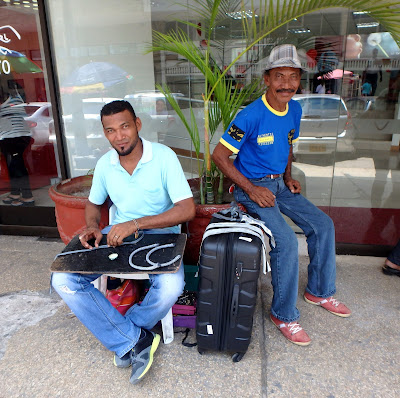Ah, I’m back “home” in Cartagena for a few weeks. It’s been fun reacquainting myself with the maze of Old City streets, drinking tropical fruit drinks, eating coconut rice, catching up with people, watching the Caribbean fisherman, and sweating in relishing the heat….
But more on all of that in a later post. What I may be most thrilled about is that I brought here with me two suitcases which had been deemed throwaways and they are now back in full working order!!
Excuse the “country dropping”, but while traveling in Europe last year, I used my sturdy Rick Steves roll aboard suitcase. In Spain, the rubber tread came off of one of the wheels. “Ay perdone señora, but I am sorry, that cannot be fixed” I was told at repair shops I visited. No biggie; I dealt with the crookedly rolling bag.
In Italy, while running from one train to catch another, one of the suitcase “feet” fell off. “Mi dispiace, signora, no repair possible.” Now I had a bag that stood even more lopsided—if I forgot to stand it up by a wall, the bag was on the ground. Could be dangerous should an unsuspecting toddler walk by; I need to do something.
In the U.S., a call to the Rick Steves store said replacement wheels and feet were not available, but they’d be happy to sell me a new bag. “But it’s still functional!”, as a London friend of mine said. She was right….why are we often told that the best way to "fix" a broken item is to replace it? I knew just where it could be fixed: there are guys in Cartagena who have a street workshop right in front of the ATM I always used.
Fast forward to now and my spur of the moment trip to Colombia. Not only am I here to update myself for my vacation rental work, and all the reasons above, but another goal was to get my bag working like new again!! I had brought along my sister’s “unfixable” roll aboard as well. Sure enough, went to my former bank & right in front of that I found Luis & his father, working away. A day later I had two fully functional rolling carry-ons.
So my recommendation to you? Come to Cartagena for sure — it’s a UNESCO world heritage site well worth a visit, easy to get to, & the exchange rate is currently in most tourists' favor. But as a bonus, bring your broken luggage along with you, visit Talabartería Luis & head home with a “new” bag!
 |
| Luis's father told me he has been working here for some 40 years! |
 |
| They fix luggage, briefcases, purses & leather paintings. Located in front of Davivienda bank on Panama St |







